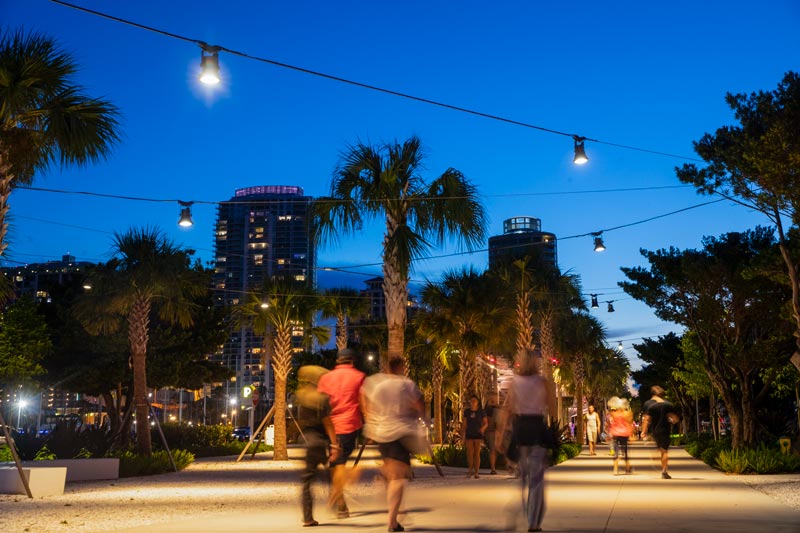Catenary lighting is the use of structural cables to suspend lights. Unchained from the clutter and range limitations of pole or wall mounted systems, designers are free to let light, shadow, and their imagination define the space.
When thinking about a catenary lighting system for your next project, it is helpful to start by considering the following:
Type, Location, and Elevation of Lights – Height, color and intensity will all affect the mood of the space. Are there feature elements to be lit and what sort of effects do they need or are the lights themselves to become the feature of the installation. When considering the height of the cable installation, it is worth noting that there will need to be some allowance for sag or deflection in the cables. Typically, if a little more sag can be accommodated, this will have the effect of reducing the loads on wall brackets and poles.
Other elements which might need to be hung from the cables – Catenary Lighting systems in the public realm provide opportunities for additional elements to be suspended from the cable system. Some common examples are seasonal decorations, festive or permanent banners, and even security cameras. Giving thought to the location, size and weight of all possible requirements will allow the cable system to be designed with sufficient capacity.
Possible Mounting Points – when thinking about cable layout options, don’t let the cables determine where the luminaires can be placed. Establish the luminaire locations in accordance with the lighting needs first, before identifying possible cable connection points. Consider locations for poles or connections to buildings that might be capable of supporting the loads. A final step is to connect the luminaire positions with a net of cables linking between these points.
Location and capacity of supports is often a key driver for the design. For connections to buildings, owner approval can sometimes be difficult to secure. For existing buildings, some assessment of the structure may be required to assess its ability to support the cable loads. Location of underground services such as power, sewage, and drains should be accurately determined so that poles can be positioned to avoid them.
Power requirements – Consider where power can be brought into the system, how many lights can be powered on a single cable run (for lights connected in series), the size and location of control hardware. This is often a step that is overlooked early in the process, and which can guide how structural cables are grouped together, and where they are terminated.
Maintenance – Will the lights or other elements need to be accessed for cleaning or servicing? What will need to be done, what equipment will be required and how often? Improvements in reliability and performance of modern LED systems have reduced, but not eliminated maintenance requirements.

Having considered all of the above, you can look at possible cable arrangements which will allow cables to pass at or very near to the required light locations while utilizing the chosen cable mounting locations.
Once the form and geometry of the cable system is defined, it is worth investing in preliminary modelling / analysis. In this process, specialist software is used to accurately determine the loads on the cables themselves, and on the poles and wall mounting points. Analysis considers changes in temperature, wind and ice loads on the cables and light fixtures, and varied combinations of the above, as required by local design standards. Determining accurate loads for cables, poles, and connection hardware allows these items to be efficiently sized (not over or under sized) and realistic budgets to be presented to stakeholders with confidence.
With 20 years’ experience and more than 100 projects in our portfolio, Ronstan is a world leader in the design and delivery of catenary lighting projects. Our knowledgeable and helpful team is ready to guide you through all phases of the project, from concept development to execution.
See our Catenary Lighting project section for more ideas, guidance and inspiration.
For more detailed guidance on developing a catenary lighting concept, see our Catenary Lighting Design Guidelines.
For even more resources, download our comprehensive catenary lighting specific catalogue.
All images © Dirk Shadd